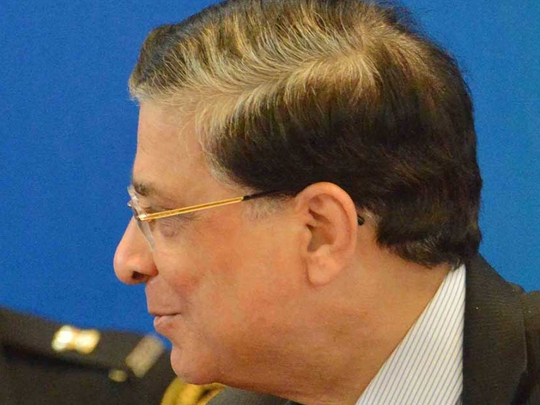
To the average Indian brought up to be relatively honest, and those others forced to toe the line out of moral cowardice, last week was a watershed.
Seven opposition parties led by the Congress party submitted a petition to the chairman of the upper house, the Rajya Sabha, seeking the removal of Deepak Misra, chief justice of India, on charges of favouritism (in the allocation of cases to the benches of Supreme Court) and corruption. The motion signed by at least 50 Rajya Sabha MPs was blocked by Vice-President Venkaiah Naidu, who said it “lacked substantial merit”.
The impeachment process is not easy. If the impeachment motion is admitted, a three-jurist panel will first investigate the charges and submit it to the vice-president. If the report proves misconduct, both houses of parliament must pass the request, approved by two-thirds of the members present in the house. If both houses approve the request, then the president could issue an order of removal. And since many of the leaders of the political parties have cases pending against them in various courts, they are likely to think again before pursuing justice in this matter.
Motion blocked
Although the impeachment motion was not passed, the damage has been done. The charges against Justice Misra range from financial corruption to arbitrary allocation of cases, and suspect acquisition of land when he was an advocate years ago.
A day before, on Thursday, the Supreme Court had dismissed petitions seeking an independent probe into CBI Special Judge B.H. Loya’s death in 2014. The cause of the death diagnosed at the time was cardiac failure.
Justice Loya was much in the news as he was handling the Sohrabuddin encounter killing — a form of extrajudicial execution — in 2005, leading later to the resignation and arrest of Amit Shah, currently ruling BJP’s president and then the home minister of Gujarat. This was the time when Narendra Modi was the chief minister of the state.The readers of this paper, far removed from India, will note from the sketch above how murky politics, judiciary, and power are in general enmeshed to form a web in which almost every Indian is caught, no matter what his financial class is.
There’s nearly no walk in life in which one way or the other no one is affected. To this writer, of late, the reality is beginning to look like the native version of the House of Cards, with those in power doing just about anything to hold on to it.
India is one of the few democracies functioning in South Asia. Or was. Parliament is no longer an effective forum of debate. Its current skewed numbers — in the last general elections in 2014, the BJP won 282 seats, leading the Hindu right-wing National Democratic Alliance tally of 336 seats in the 543-seat Lok Sabha — ensures that no matter what the bill, Modi will carry the day. And there is nothing as a conscience vote in India. Clearly no one sets much store by that hard to locate part of the heart.
Besides the one-sided numbers, the Rahul Gandhi-led Opposition is still too weak in strategies and content. The basic equivocating national character has not changed; demonetisation and digitisation have not curbed the corruption if one’s daily experience is any indication.
Corporate India as ever remains spineless: the worst budget is still complimented, though internally the tycoons may fume. The big media is a laugh. The small media does not really matter because the few operating with a sense of purpose are run on charity; they have no idea what it’s to be confronting the market — if that time will ever come. That just means the values at play have no real test. No one talks in the government; or outside of it. Academic institutions, like the JNU, are slowly being brought under political control.
Nevertheless, officially Indians are told — repeatedly and too often — that they are doing well. The figures the government releases are always on the positive side. Nothing seem to reflect these though. Inflation is up. So is unemployment. Real estate, once the largest employer, is dull — the building tycoons mired in their own fantastic history of corruption.
Bribery charges
And as of last week, the last straw. That august body, the shrinking of the Supreme Court into a joke. Indeed the impeachment of Justice Misra was blocked. But the reputation of the job is in tatters. That is not a good thing to happen even in the best of times. There is a general criticism that the Opposition is damaging the credibility of the institution. That all of it is political. Maybe. But the fact remains that nothing in India, no institution or public personality, is beyond reproach. That there is nothing to look up to. In short, a vacuum of icons in a culture and religion that is nothing without them.
In the transcripts that the CBI (Central Bureau of Investigation) released regarding a telephonic conversation between three parties (a middle man, a retired justice, and the owner of a medical school whose licence is in question, and who expects a favourable judgement) which the Opposition believes is related to bribery charges allegedly involving the chief justice, the Supreme Court is often referred to as the ‘temple’, and bribery as prasad (offering). Neat reversals. No idols.
C.P. Surendran is a senior journalist based in India.












